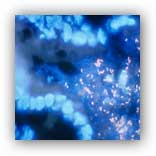|
NIH-funded pre-clinical study links gut microbes and
the immune system to a genetic disorder that can
cause stroke and seizures.

A study in mice and humans suggests that bacteria in
the gut can influence the structure of the brain’s
blood vessels, and may be responsible for producing
malformations that can lead to stroke or epilepsy.
The research, published in Nature, adds to an
emerging picture that connects intestinal microbes
and disorders of the nervous system.
Cerebral cavernous malformations (CCMs) are clusters
of dilated, thin-walled blood vessels that can lead
to seizures or stroke when blood leaks into the
surrounding brain tissue.
A team of scientists at the University of
Pennsylvania investigated the mechanisms that cause
CCM lesions to form in genetically engineered mice
and discovered an unexpected link to bacteria in the
gut.
When bacteria were eliminated the number of lesions
was greatly diminished.
"This study is exciting because it shows that
changes within the body can affect the progression
of a disorder caused by a genetic mutation,” said
Jim I. Koenig, Ph.D., program director at NINDS.
The researchers were studying a well-established
mouse model that forms a significant number of CCMs
following the injection of a drug to induce gene
deletion.
However, when the animals were relocated to a new
facility, the frequency of lesion formation
decreased to almost zero.
“It was a complete mystery. Suddenly, our normally
reliable mouse model was no longer forming the
lesions that we expected,” said Mark L. Kahn, M.D.,
professor of medicine at the University of
Pennsylvania, and senior author of the study.
“What’s interesting is that this variability in
lesion formation is also seen in humans, where
patients with the same genetic mutation often have
dramatically different disease courses.”
While investigating the cause of this sudden
variability, Alan Tang, a graduate student in Dr.
Kahn’s lab, noticed that the few mice that continued
to form lesions had developed bacterial abscesses in
their abdomens — infections that most likely arose
due to the abdominal drug injections.
The abscesses contained Gram-negative bacteria, and
when similar bacterial infections were deliberately
induced in the CCM model animals, about half of them
developed significant CCMs.
“The mice that formed CCMs also had abscesses in
their spleens, which meant that the bacteria had
entered the bloodstream from the initial abscess
site,” said Tang. “This suggested a connection
between the spread of a specific type of bacteria
through the bloodstream and the formation of these
blood vascular lesions in the brain.”
The question remained as to how bacteria in the
blood could influence blood vessel behavior in the
brain.
Gram-negative bacteria produce molecules called
lipopolysaccharides (LPS) that are potent activators
of innate immune signaling.
When the mice received injections of LPS alone, they
formed numerous large CCMs, similar to those
produced by bacterial infection.
Conversely, when the LPS receptor, TLR4, was
genetically removed from these mice they no longer
formed CCM lesions.
The researchers also found that, in humans, genetic
mutations causing an increase in TLR4 expression
were associated with a greater risk of forming CCMs.
“We knew that lesion formation could be driven by
Gram-negative bacteria in the body through LPS
signaling,” said Kahn.
“Our next question was whether we could prevent
lesions by changing the bacteria in the body.”
The researchers explored changes to the body’s
bacteria (microbiome) in two ways.
First, newborn CCM mice were raised in either normal
housing or under germ-free conditions.
Second, these mice were given a course of
antibiotics to “reset” their microbiome.
In both the germ-free conditions and following the
course of antibiotics, the number of lesions was
significantly reduced, indicating that both the
quantity and quality of the gut microbiome could
affect CCM formation.
Finally, a drug that specifically blocks TLR4 also
produced a significant decrease in lesion formation.
This drug has been tested in clinical trials for the
treatment of sepsis, and these findings suggest a
therapeutic potential for the drug in the treatment
of CCMs, although considerable research remains to
be done.
“These results are especially exciting because they
show that we can take findings in the mouse and
possibly apply them at the human patient
population,” said Koenig.
“The drug used to block TLR4 has already been tested
in patients for other conditions, and it may show
therapeutic potential in the treatment of CCMs,
although considerable research still remains to be
done.”
Kahn and his colleagues plan to continue to study
the relationship between the microbiome and CCM
formation, particularly as it relates to human
disease.
Although specific gene mutations have been
identified in humans that can cause CCMs to form,
the size and number varies widely among patients
with the same mutations.
The group next aims to test the hypothesis that
differences in the patients’ microbiomes could
explain this variability in lesion number.
The study was funded by the National Institute of
Neurological Disorders and Stroke (NINDS), a part of
the National Institutes of Health.
For more information
Nature
Endothelial TLR4 and the microbiome drive cerebral
cavernous
Link...
University of Pennsylvania
Link...
U.S. National Institutes of Health
Link...
MDN |